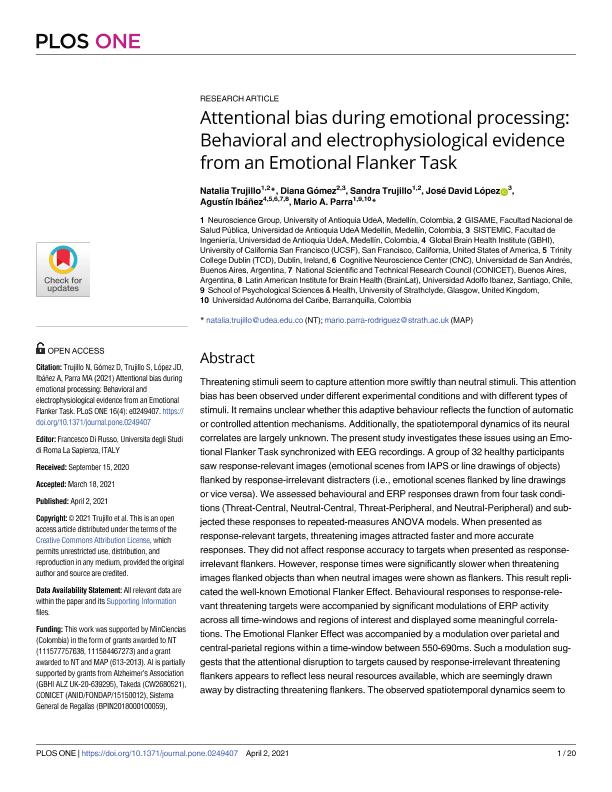Mostrar el registro sencillo del ítem
dc.contributor.author
Trujillo, Natalia
dc.contributor.author
Gómez, Diana
dc.contributor.author
Trujillo, Sandra
dc.contributor.author
López, José David
dc.contributor.author
Ibañez, Agustin Mariano

dc.contributor.author
Parra, Mario A.
dc.date.available
2022-04-13T19:11:33Z
dc.date.issued
2021-04-02
dc.identifier.citation
Trujillo, Natalia; Gómez, Diana; Trujillo, Sandra; López, José David; Ibañez, Agustin Mariano; et al.; Attentional bias during emotional processing: Behavioral and electrophysiological evidence from an emotional flanker task; Public Library of Science; Plos One; 16; 4; 02-4-2021; 1-20
dc.identifier.uri
http://hdl.handle.net/11336/155256
dc.description.abstract
Threatening stimuli seem to capture attention more swiftly than neutral stimuli. This attention bias has been observed under different experimental conditions and with different types of stimuli. It remains unclear whether this adaptive behaviour reflects the function of automatic or controlled attention mechanisms. Additionally, the spatiotemporal dynamics of its neural correlates are largely unknown. The present study investigates these issues using an Emotional Flanker Task synchronized with EEG recordings. A group of 32 healthy participants saw response-relevant images (emotional scenes from IAPS or line drawings of objects) flanked by response-irrelevant distracters (i.e., emotional scenes flanked by line drawings or vice versa). We assessed behavioural and ERP responses drawn from four task conditions (Threat-Central, Neutral-Central, Threat-Peripheral, and Neutral-Peripheral) and subjected these responses to repeated-measures ANOVA models. When presented as response-relevant targets, threatening images attracted faster and more accurate responses. They did not affect response accuracy to targets when presented as response-irrelevant flankers. However, response times were significantly slower when threatening images flanked objects than when neutral images were shown as flankers. This result replicated the well-known Emotional Flanker Effect. Behavioural responses to response-relevant threatening targets were accompanied by significant modulations of ERP activity across all time-windows and regions of interest and displayed some meaningful correlations. The Emotional Flanker Effect was accompanied by a modulation over parietal and central-parietal regions within a time-window between 550-690ms. Such a modulation suggests that the attentional disruption to targets caused by response-irrelevant threatening flankers appears to reflect less neural resources available, which are seemingly drawn away by distracting threatening flankers. The observed spatiotemporal dynamics seem to concur with understanding of the important adaptive role attributed to threat-related attention bias.
dc.format
application/pdf
dc.language.iso
eng
dc.publisher
Public Library of Science

dc.rights
info:eu-repo/semantics/openAccess
dc.rights.uri
https://creativecommons.org/licenses/by/2.5/ar/
dc.subject
ATTENTIONAL BIAS
dc.subject
ADAPTIVE BEHAVIOUR
dc.subject
EEG
dc.subject.classification
Neurociencias

dc.subject.classification
Medicina Básica

dc.subject.classification
CIENCIAS MÉDICAS Y DE LA SALUD

dc.title
Attentional bias during emotional processing: Behavioral and electrophysiological evidence from an emotional flanker task
dc.type
info:eu-repo/semantics/article
dc.type
info:ar-repo/semantics/artículo
dc.type
info:eu-repo/semantics/publishedVersion
dc.date.updated
2022-04-07T21:04:19Z
dc.identifier.eissn
1932-6203
dc.journal.volume
16
dc.journal.number
4
dc.journal.pagination
1-20
dc.journal.pais
Estados Unidos

dc.journal.ciudad
San Francisco
dc.description.fil
Fil: Trujillo, Natalia. Universidad de Antioquia; Colombia
dc.description.fil
Fil: Gómez, Diana. Universidad de Antioquia; Colombia
dc.description.fil
Fil: Trujillo, Sandra. Universidad de Antioquia; Colombia
dc.description.fil
Fil: López, José David. Universidad de Antioquia; Colombia
dc.description.fil
Fil: Ibañez, Agustin Mariano. Universidad de San Andrés; Argentina. Trinity College Dublin; Irlanda. Consejo Nacional de Investigaciones Científicas y Técnicas; Argentina. University of San Francisco; Estados Unidos. Universidad Adolfo Ibañez; Chile
dc.description.fil
Fil: Parra, Mario A.. Universidad de Antioquia; Colombia. University of Strathclyde; Reino Unido. Universidad Autónoma del Caribe; Colombia
dc.journal.title
Plos One

dc.relation.alternativeid
info:eu-repo/semantics/altIdentifier/doi/http://dx.doi.org/10.1371/journal.pone.0249407
dc.relation.alternativeid
info:eu-repo/semantics/altIdentifier/url/https://journals.plos.org/plosone/article?id=10.1371/journal.pone.0249407
Archivos asociados
